Imagine this: you’re making critical decisions every day, leading your team, guiding your organization — yet there’s a high chance your brain is silently sabotaging you.
Sound dramatic? It’s not.
Studies show that 90% of executives admit they’ve made decisions influenced by cognitive biases without even realizing it.
Here’s the hard truth: no matter how smart or experienced you are, your brain is wired to take mental shortcuts that often lead to flawed conclusions. As a leader, these mental traps don’t just affect you — they impact your entire team and the decisions that shape your business.
What if you could avoid these hidden traps and lead with more clarity and objectivity?
In this article, we’re going to break down fifteen cognitive biases that are likely sabotaging your leadership and, more importantly, show you how to avoid them.
Let’s get cracking!
Cognitive Trap #1: Bandwagon Effect
You tend to align your beliefs or behaviors with the majority or popular opinion. This is known as the bandwagon effect — the tendency to do or believe something because others are doing it.
How It Sabotages Your Leadership:
The bandwagon effect can lead to conformist thinking and decisions that lack originality or critical evaluation. If you follow trends or popular opinions without assessing their validity or relevance to your specific context, you might miss out on innovative solutions or make decisions that aren’t well-suited to your team’s needs.
For example, if a ‘new’ management fad becomes popular, you might adopt it without considering whether it actually aligns with your team’s needs or if it will truly benefit your organization.
How to Avoid It:
Evaluate independently: Assess ideas and strategies based on their merits and fit for your situation, rather than their popularity.
Encourage critical thinking: Foster a culture where team members are encouraged to question and critically evaluate popular opinions. First Principles Thinking is a powerful approach to critical thinking (refer First Principles Thinking: How Elon Musk Built SpaceX for a detailed discussion.)
Be open to innovation: Consider alternative approaches that might be more effective for your specific challenges.
Cognitive Trap #2: The Ostrich Effect
When things start going wrong, do you tend to bury your head in the sand, hoping the problem will resolve itself? This is the ostrich effect, where leaders avoid dealing with unpleasant information or situations, preferring to ignore them rather than face the uncomfortable truth.
How It Sabotages Your Leadership:
Avoiding problems won’t make them disappear — it will only make them worse.
The ostrich effect can prevent you from addressing critical issues, whether it’s a brewing team conflict, declining project performance, or looming financial challenges. By the time you finally confront the issue, the damage is often far greater than it would have been if you’d dealt with it early on.
Think of a team member who’s consistently underperforming. Instead of having that difficult conversation or putting them on a performance plan, you ignore the issue, ‘hoping’ it’ll improve on its own. But it doesn’t, and soon the entire team’s productivity suffers.
How to Avoid It:
Face issues head-on: As soon as you notice a problem, tackle it. The sooner you address it, the easier it will be to resolve.
Create a feedback loop: Regularly check in with your team, projects, and performance metrics to spot potential issues before they escalate.
Get comfortable with discomfort: Difficult conversations and tough decisions are part of leadership. Avoiding them will only hurt your credibility and team in the long run. Normalize discomfort, and it will start becoming comfortable for you and your team.
Cognitive Trap #3: Confirmation Bias
You’ve probably been guilty of this without even realizing it: seeking out information that supports what you already believe while conveniently ignoring anything that contradicts it. This is confirmation bias, and it’s one of the most common — and dangerous — traps leaders fall into.
How It Sabotages Your Leadership:
When you’re stuck in confirmation bias, you don’t see the full picture. Instead of making well-rounded decisions, you end up reinforcing your own assumptions. Whether it’s choosing a strategy, hiring a new team member, or navigating a crisis, confirmation bias can blind you to critical details that might be telling you to take a different path.
For instance, imagine you’re convinced that a particular project is going to succeed. You focus on all the positive reports, praise the team’s work, and ignore the early warning signs of failure. By the time you realize the risks, it’s too late, and the fallout affects not just you but your entire team.
How to Avoid It:
Actively seek opposing viewpoints: Before making a decision, challenge yourself to find information or opinions that contradict your own. Encourage your team to play devil’s advocate.
Foster psychological safety: Create an environment where your team feels safe to speak up and challenge your ideas. Often, the insights you’re missing are the ones you’re avoiding.
Ask better questions: Instead of asking, “How can this succeed?” ask, “What might cause this to fail?” By flipping the question, you open yourself up to a more balanced view. This is the Inversion Principle, one of the many frameworks covered in The Leader’s Playbook.
Cognitive Trap #4: Anchoring Bias
Think back to the last time you made a big decision. What was the first piece of information you got? That initial bit of data — whether it was a suggestion, a price, or an idea — likely shaped everything that followed. This is anchoring bias, the tendency to latch onto the first information we receive and let it overly influence the final outcome.
How It Sabotages Your Leadership:
Anchoring bias can lead you to make decisions that are skewed by that initial “anchor,” even if it’s irrelevant or incomplete.
In negotiations, you might settle for a number that’s far from ideal just because it was the first figure tossed around. In strategic planning, you could fixate on the first solution presented, ignoring better alternatives that come up later.
Imagine you’re setting a budget for a new project. If the first estimate you hear is too high or too low, you might get anchored to that figure and make decisions around it, even if it doesn’t reflect reality. That’s how anchoring bias quietly drags down your leadership.
How to Avoid It:
Delay judgment: Resist the urge to make quick decisions based on initial information. Take the time to gather multiple perspectives before committing. System 2 thinking can be a powerful way to approach the problem (check out System 1 and 2 Thinking: When to Trust Your Gut and When to Think Twice as a Leader for some inspiration.)
Reframe decisions: Instead of focusing on the first option or number presented, ask yourself, “What are the alternatives?” This helps widen your view.
Get a second opinion: In negotiations or strategic discussions, bring in fresh eyes. A neutral perspective can help you break free from that initial anchor.
Cognitive Trap #5: Sunk Cost Fallacy
You’ve invested time, money, and effort into a project, so you keep pushing forward — even when it’s clear it’s not working. Sound familiar? This is the sunk cost fallacy. It’s the idea that you should continue something just because you’ve already invested so much into it, even when cutting your losses would be smarter.
How It Sabotages Your Leadership:
As a leader, you’re expected to know when to pull the plug. But the sunk cost fallacy makes you hesitant.
You don’t want to feel like you’ve wasted resources, so you continue down the wrong path, pouring in more time, money, or effort in the hope that things will turn around. Unfortunately, this rarely works out.
Take the case of a failing product launch. You’ve already spent months and thousands of dollars on development, but it’s clear from early customer feedback that the market just isn’t interested. Instead of cutting your losses, you keep going — hoping that with just a little more effort, it will work out. By the time you accept it’s a failure, you’ve lost far more than you needed to.
How to Avoid It:
Focus on future value: Instead of looking at what you’ve already spent, ask, “What’s the best decision going forward?” Prioritize future gains over past investments. The Impact-Effort matrix provides a structured approach to plotting out what really matters (discussed in detail here: Stop Wasting Time: The Simple Matrix That Can Change Your Team’s Productivity.)
Set clear exit points: Before you start a project, decide in advance when you’ll stop if things aren’t going well. Having predefined exit criteria helps you avoid emotional decisions later.
Regularly reassess: Build check-in points into your projects where you objectively assess progress. If it’s not working, be willing to pivot or quit.
Cognitive Trap #6: Availability Heuristic
The availability heuristic is the mental shortcut where you rely on immediate examples that come to mind when evaluating a situation. In leadership, this can cause you to overestimate the importance or likelihood of something simply because it’s recent, dramatic, or memorable.
How It Sabotages Your Leadership:
This bias makes you focus on what’s most vivid rather than what’s most relevant.
For instance, if a single employee complaint stands out in your mind, you might overreact, thinking the issue is bigger than it is. Or, if a recent success is still fresh, you might assume everything is running smoothly, ignoring underlying problems.
Let’s say you’re making decisions about team performance. If you’ve recently dealt with one team member’s mistake, you might unfairly judge the entire team’s performance based on that one instance, even if the overall track record is strong.
How to Avoid It:
Rely on data, not anecdotes: Use hard data and facts to guide your decisions, rather than just relying on what’s top of mind. Look at multiple viewpoints, not just one.
Take a step back: Before reacting, ask yourself: “Is this one example representative of the bigger picture?”
Regularly review the long-term trends: Zoom out and look at performance or results over time. This will give you a clearer view and reduce knee-jerk reactions.
Cognitive Trap #7: Endowment Effect
You place a higher value on things simply because you own them. This is known as the endowment effect — the tendency to overvalue items or ideas merely because they are yours.
How It Sabotages Your Leadership:
The endowment effect can lead to resistance to change and poor decision-making. If you’re overly attached to a particular process, project, or idea just because it’s yours, you might be unwilling to consider better alternatives or improvements. This can prevent innovation and hinder your team’s progress.
For instance, if you’ve invested significant time in developing a particular strategy, you might cling to it even when data suggests it’s ineffective, simply because of your personal investment. Or if you have worked with a set of team members for a while, you might defend them even when they made a mistake, simply because of your emotional connection to the team.
How to Avoid It:
Seek objective input: Solicit opinions from others who are not emotionally attached to the project or idea.
Evaluate data and outcomes: Make decisions based on evidence and performance metrics rather than personal attachment. Probabilistic Thinking is a powerful framework that can help you turn uncertainties into concrete decision outcomes.
Be open to change: Foster a culture that embraces change and encourages continuous improvement.
Cognitive Trap #8: Groupthink
You’ve got a smart, capable team, but somehow, everyone always seems to be nodding their heads and agreeing with each other. When this happens, you might be falling into groupthink — the tendency for a group to prioritize harmony and consensus over critical thinking and diverse viewpoints.
How It Sabotages Your Leadership:
Groupthink stifles innovation.
Instead of your team challenging each other’s ideas and pushing for better solutions, they fall into a pattern of agreement. This leads to poor decision-making, as potential risks and better alternatives are ignored. The illusion of unity feels comfortable, but it often results in subpar outcomes.
Picture this: you’re in a meeting discussing a new initiative, and one person suggests an idea that gets immediate support. Instead of probing further or considering other options, everyone nods along, wanting to avoid conflict. The problem? That idea may not be the best one, but no one dared to speak up.
How to Avoid It:
Encourage debate: Make it clear that disagreement is healthy. Create a culture where diverse opinions are valued, and challenge your team to poke holes in ideas.
Assign a devil’s advocate: Have someone in each meeting take on the role of challenging the consensus, ensuring that alternative viewpoints are considered.
Break the echo chamber: Bring in outside perspectives to shake up the discussion, whether it’s from other teams, departments, or even external experts.
Enjoying the read? Hit the ❤️ button and share/restack 🔁 it with others who might find it helpful.
Subscribe to The Good Boss to get free articles like this every week.
Cognitive Trap #9: Halo Effect
You meet someone who impresses you — maybe they’re charismatic or have a great track record. Suddenly, everything they do seems golden ✨. This is the halo effect, where your overall impression of someone influences how you perceive everything they do.
How It Sabotages Your Leadership:
The halo effect can cause you to overestimate the capabilities of certain team members, simply because they’ve impressed you in one area. This bias can lead to favoritism or blind spots, where you fail to see someone’s flaws or shortcomings. As a result, you may over-rely on them, give them more responsibilities than they can handle, or overlook other talent in your team.
Imagine you have a star employee who always delivers. But when they start underperforming or missing deadlines, you might brush it off or blame external factors, while you hold others to a different standard. This not only damages team morale but also clouds your judgment.
How to Avoid It:
Focus on specific behaviors: Evaluate your team members based on concrete actions and outcomes, not your overall impression of them. Review their performance based on the current project they’re working on, not what they did two years ago. Check out Sight vs Insight: Are You Leading With Your Eyes or Your Mind? for some inspiration on how you can use the power of insight vs sight in making decisions.
Solicit 360-degree feedback: Get feedback from multiple sources, including peers and subordinates, to get a balanced view of someone’s performance.
Separate personal from professional: Be mindful of not letting personal likability influence your evaluation of someone’s work.
Cognitive Trap #10: Recency Bias
Leaders often fall victim to recency bias, the tendency to weigh recent events or information more heavily than past data. It’s easy to focus on what just happened rather than what has been consistently happening over time.
How It Sabotages Your Leadership:
Recency bias distorts your judgment, causing you to make decisions based on the latest developments, rather than the long-term picture.
If a team member has been performing well for months but has a single bad week, you might unfairly judge them on that recent dip. Similarly, if a project has been struggling but sees a brief spike in progress, you might assume it’s finally turning around, when in reality, the underlying problems are still there.
Imagine you’re evaluating quarterly performance, and the last few weeks have been particularly chaotic. Recency bias could lead you to believe the entire quarter was a disaster, even if the earlier months were highly productive.
How to Avoid It:
Look at long-term trends: Don’t rely on the most recent data alone. Always zoom out and analyze performance or results over a longer time frame. For some inspiration, check out Mind Boxing: How Leaders (Should) Spend Their Time, which is a framework I developed to help you balance the time you spend between tactics and long-term strategy.
Regular review checkpoints: Set regular intervals for reviewing performance to avoid overemphasizing short-term fluctuations.
Balance feedback: When giving feedback, consider the person’s overall track record, not just their latest actions.
Cognitive Trap #11: The Dunning-Kruger Effect
Ever met someone who seems completely confident in their abilities, even when they’re woefully underqualified? That’s the Dunning-Kruger effect in action — where people with limited knowledge or skill in an area overestimate their competence.
And yes, it could be happening to you too.
How It Sabotages Your Leadership:
The Dunning-Kruger effect can cause leaders to overlook their own knowledge gaps or blind spots, making decisions based on false confidence.
This not only leads to poor outcomes but also discourages growth, as you don’t recognize where you need to improve. Similarly, you might promote or overvalue employees who exhibit unwarranted confidence, while underestimating quieter, more competent team members.
Consider a scenario where you’re making decisions about a new technology that you’re not well-versed in. You assume you know enough to make the call, ignoring the input of your tech experts. As a result, you implement a solution that ends up being inefficient or costly.
How to Avoid It:
Know what you don’t know: Regularly assess your own knowledge gaps and seek out expert advice when you’re venturing outside your expertise. Be aware of the concept of the Circle of Competence and how that impacts your outlook. Use the Johari Window to identify your blind spots. Both of these frameworks are discussed in The Leader’s Playbook.
Encourage skill development: Instead of promoting based on confidence, promote based on skill and competence. Invest in training to fill in gaps.
Stay curious: Cultivate a mindset of continuous learning. Acknowledge that there’s always more to learn, no matter how experienced you are. The best leaders are life-long learners.
Cognitive Trap #12: Projection Bias
You tend to assume that others think and feel the same way you do. This is known as projection bias — the tendency to project your own thoughts, feelings, and perspectives onto others.
How It Sabotages Your Leadership:
Projection bias can lead to misunderstandings and ineffective communication. If you assume that your team members share your views or motivations without actually asking them, you might make decisions that don’t align with their needs or concerns. This can result in misaligned goals, unmet expectations, and a lack of engagement.
For example, if you believe that everyone on your team is as passionate about a project as you are, you might overlook signs of burnout or disinterest, leading to decreased morale and productivity.
How to Avoid It:
Engage in active listening: Regularly check in with your team members to understand their perspectives and needs. Listen more than you speak.
Ask for feedback: Encourage open dialogue and solicit feedback to ensure your assumptions align with reality.
Diversify your perspective: Seek out different viewpoints and experiences to broaden your understanding of your team’s dynamics.
Cognitive Trap #13: Self-Serving Bias
You tend to attribute your successes to your own skills and efforts, while blaming external factors for your failures. This is known as self-serving bias — the tendency to view oneself more favorably than reality might warrant.
How It Sabotages Your Leadership:
Self-serving bias can distort your self-assessment and lead to a lack of accountability.
If you attribute your successes solely to your own capabilities while blaming external factors for failures, you miss out on learning opportunities and might alienate your team. This can create a culture where failures are ignored and successes are overstated, ultimately affecting team morale and performance.
For instance, if a project succeeds, you might take full credit, but if it fails, you might blame the team or external conditions, overlooking any role you might have played in the failure. The best leaders know how to conquer this bias by doing the exact opposite: they attribute successes to their teams while take accountability for failures.
How to Avoid It:
Be Accountable: Regularly assess your contributions to both successes and failures. Check out The 7 Habits of Highly Effective Leaders for some inspiration.
Seek honest feedback: Encourage team members to provide constructive feedback and be open to it.
Share credit and responsibility: Acknowledge your team’s contributions and take responsibility for shortcomings. Know that ultimately, your team’s success is your success.
Cognitive Trap #14: Illusion of Control
You tend to overestimate your ability to control or influence outcomes that are actually outside of your control. This is known as the illusion of control — the tendency to believe that you have more control over events than you actually do.
Check out Confessions of a Middle Manager: Secrets, Regrets and Guilty Pleasures, where I discuss how middle managers think they have control, but are actually powerless in most cases.
How It Sabotages Your Leadership:
The illusion of control can lead to risky decisions and unrealistic expectations.
Believing you can control or influence outcomes that are beyond your reach may result in overconfidence and failure to prepare for uncertainties. This can lead to poor planning and strategy, as you might overlook potential risks or external factors.
For example, if you believe that your team’s performance can be entirely controlled by your management style, you might overlook external factors like market conditions or team members’ personal issues, leading to ineffective strategies.
How to Avoid It:
Acknowledge uncertainty: Recognize and plan for factors that are beyond your control.
Use risk management: Implement strategies to mitigate risks and prepare for possible contingencies. Check out The Animal Risk Matrix: How to Spot, Prioritize, and Manage Risks Like a Pro for some inspiration.
Seek diverse opinions: Consult with others to gain a broader perspective on factors influencing outcomes.
Cognitive Trap #15: Hindsight Bias
You see events as being more predictable after they have occurred. This is known as hindsight bias — the tendency to perceive past events as having been more predictable than they actually were. This bias also has a role to play in the world of gambling, where past loterry winning numbers or draws tend to be seen as “more likely” to repeat in the future.
How It Sabotages Your Leadership:
Hindsight bias can lead to unfair judgment of past decisions and can hinder learning.
If you believe that outcomes were obvious or predictable after the fact, you may be too harsh on yourself or others for past decisions. This can prevent you from understanding the true nature of decision-making and learning from past experiences.
For instance, if a project fails, hindsight bias might make you think that the failure was obvious and that you should have seen it coming, potentially causing you to overlook the genuine challenges and uncertainties faced at the time.
How to Avoid It:
Document decisions: Keep records of the decision-making process and the factors considered at the time. As humans, we can forget to acknowledge those factors after the fact if we don’t have a record.
Reflect critically: Analyze past decisions with an understanding of the context and limitations faced.
Use the Animal Risk Matrix: This is a powerful risk-management framework that you can use to weigh the risks and make more informed decisions. We discussed this in detail here: The Animal Risk Matrix: How to Spot, Prioritize, and Manage Risks Like a Pro.
Conclusion: Avoiding the Cognitive Traps that Sabotage Your Leadership
Cognitive biases are hidden traps that can quietly influence your leadership decisions and team outcomes. By understanding these mental shortcuts and how they affect your thinking, you’re already a step ahead in becoming a more effective leader.
Leadership isn’t about being perfect — it’s about being aware.
Check out the additional references below to learn more about how you can lead with more awareness and confidence.
References
Articles:
System 1 and 2 Thinking: When to Trust Your Gut and When to Think Twice as a Leader
The Animal Risk Matrix: How to Spot, Prioritize, and Manage Risks Like a Pro
The 5 Whys Framework: How To Move From Symptoms to Root Causes
Stop Wasting Time: The Simple Matrix That Can Change Your Team’s Productivity
Books:
Thinking, Fast and Slow by Daniel Kahneman. Explore how our brains make decisions and the biases that impact us.
The Art of Thinking Clearly by Rolf Dobelli. A simple guide to understanding cognitive biases and how to avoid them.
Blindspot: Hidden Biases of Good People by Mahzarin R. Banaji and Anthony G. Greenwald. Learn about hidden biases that affect our decisions, even when we believe we’re being objective.
Decisive: How to Make Better Choices in Life and Work by Chip Heath and Dan Heath. A practical guide to making better decisions by overcoming cognitive traps.
Clear Thinking: The Art and Science of Making Better Decisions by Shane Parish
TED/TEDx Talks:
The Danger of a Single Story by Chimamanda Ngozi Adichie. This talk explores how our biases are shaped by the stories we tell and hear.
Are We in Control of Our Decisions? by Dan Ariely. A look at how irrational forces shape our decisions and how to manage them.
How to Outsmart Your Own Unconscious Bias by Valerie Alexander. A powerful talk about identifying and overcoming unconscious bias in leadership.
The Leadership OS 🧠
Looking to discover the hidden system behind every great leader? Check out The Leadership OS, a complete system with 4 layers, 23 skills, and 75 frameworks to unlock your leadership potential.
The Ultimate Leadership Toolkit Bundle 🛠️
Ready to take your leadership to a whole new level? Unlock the full power of the best leadership frameworks and tools with The Ultimate Leadership Toolkit Bundle! From application guides to mind-maps to posters to worksheets and much more - this is your ultimate leadership resource!
👉🏼 Grab your copy of the bundle
🎁 Paid subscribers to The Good Boss enjoy FREE access to the bundle! (worth $210+) Not a paid member? You can upgrade here.
👋🏻 Let’s stay in touch - connect with me on LinkedIn.
PS: If you’re enjoying The Good Boss, will you take 2 seconds and hit the ❤️ button and share/restack 🔁 it with others who might find it helpful? It goes a long way in helping me grow the newsletter. Thank you!
If you are not already, subscribe to The Good Boss for free articles like this every week.


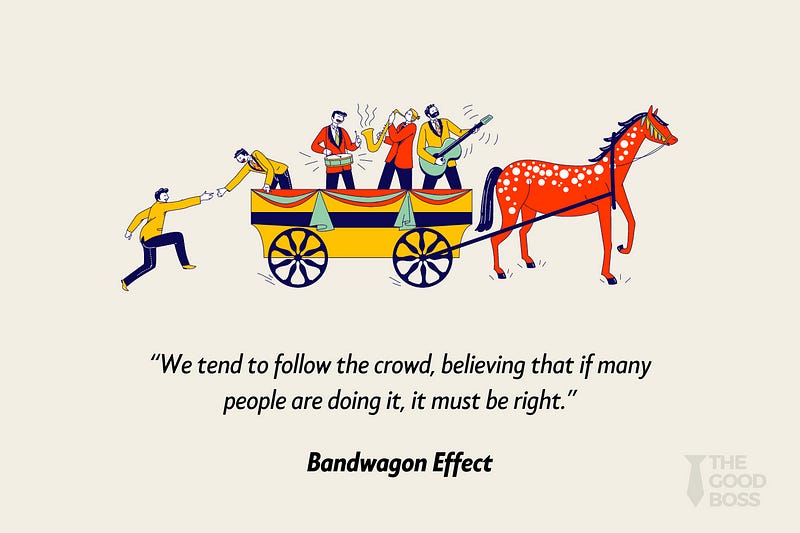








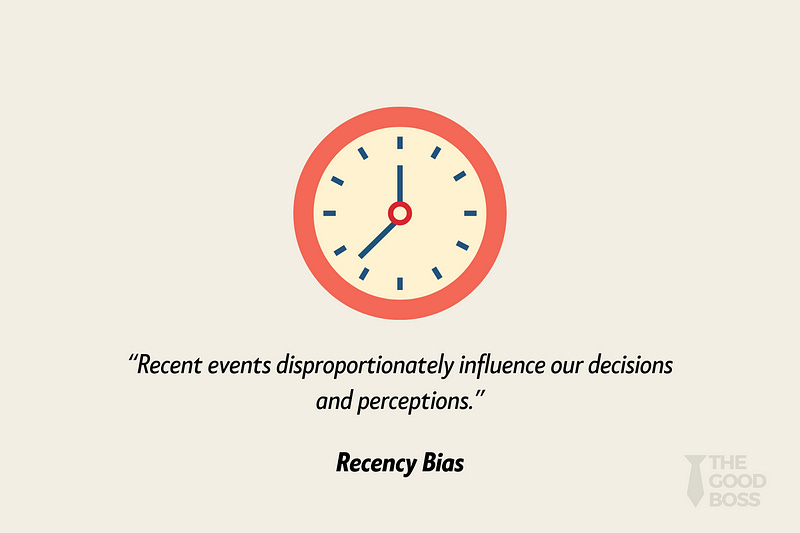
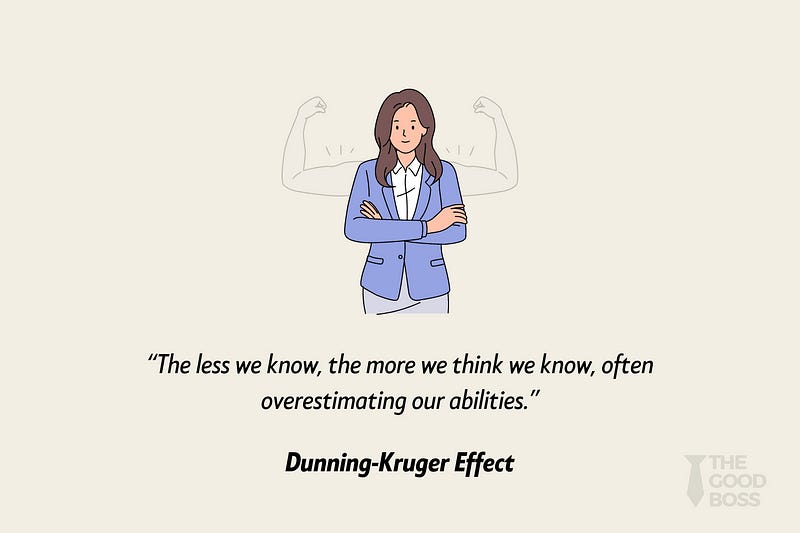

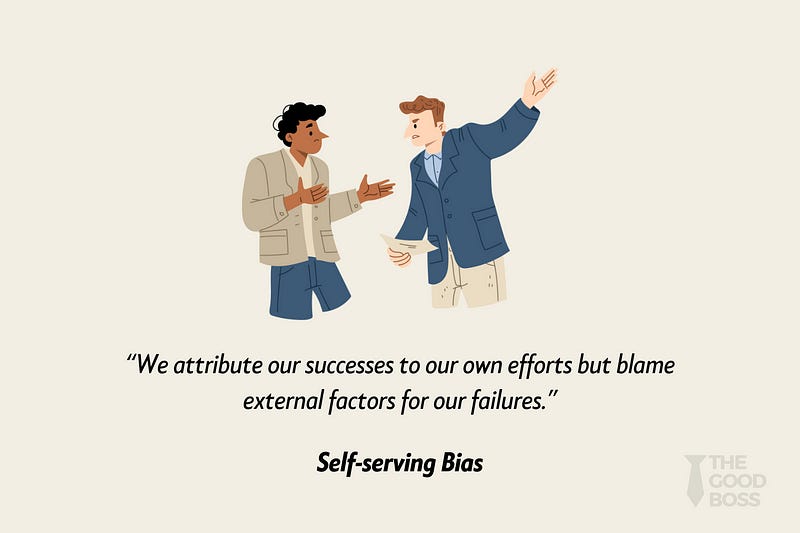


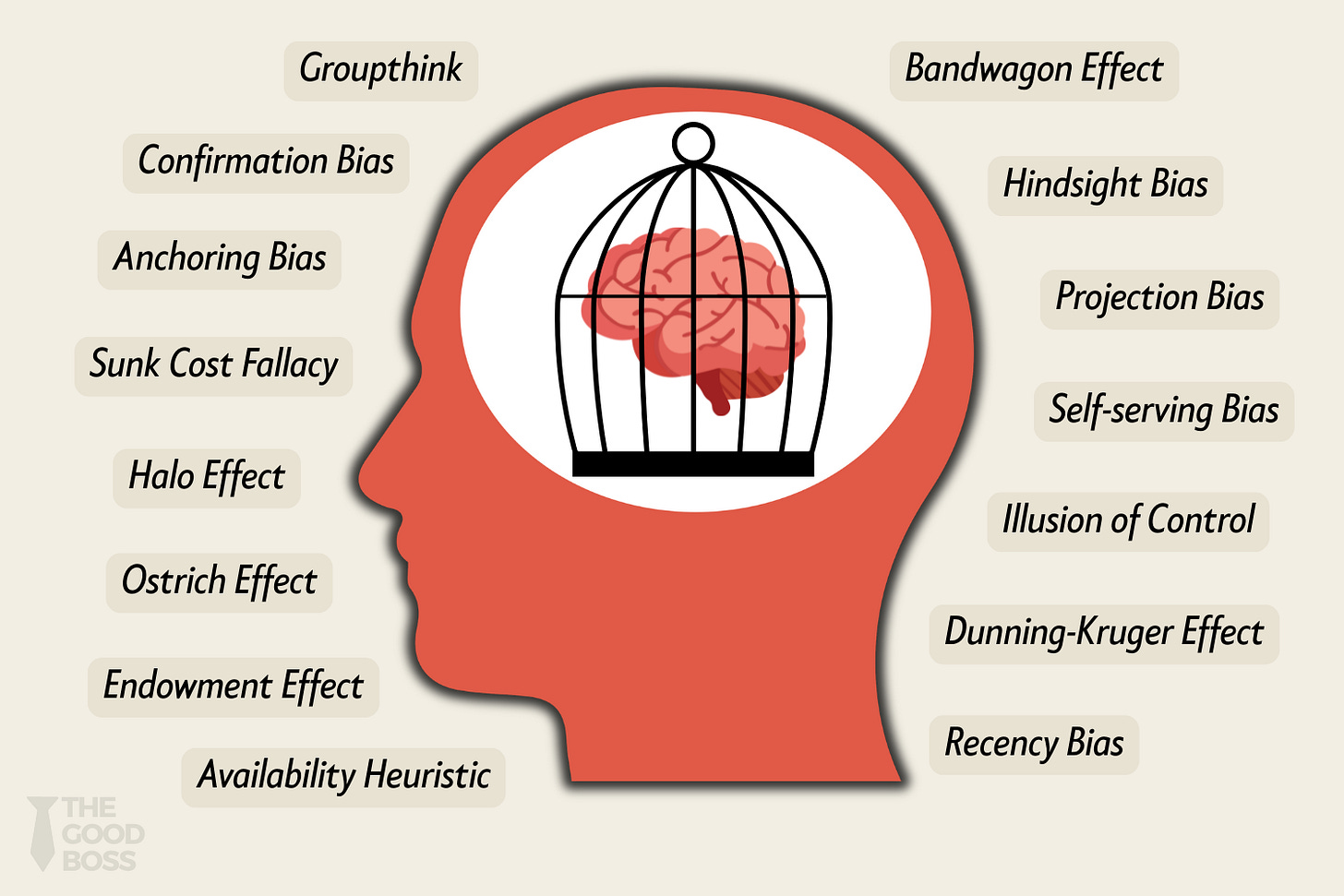
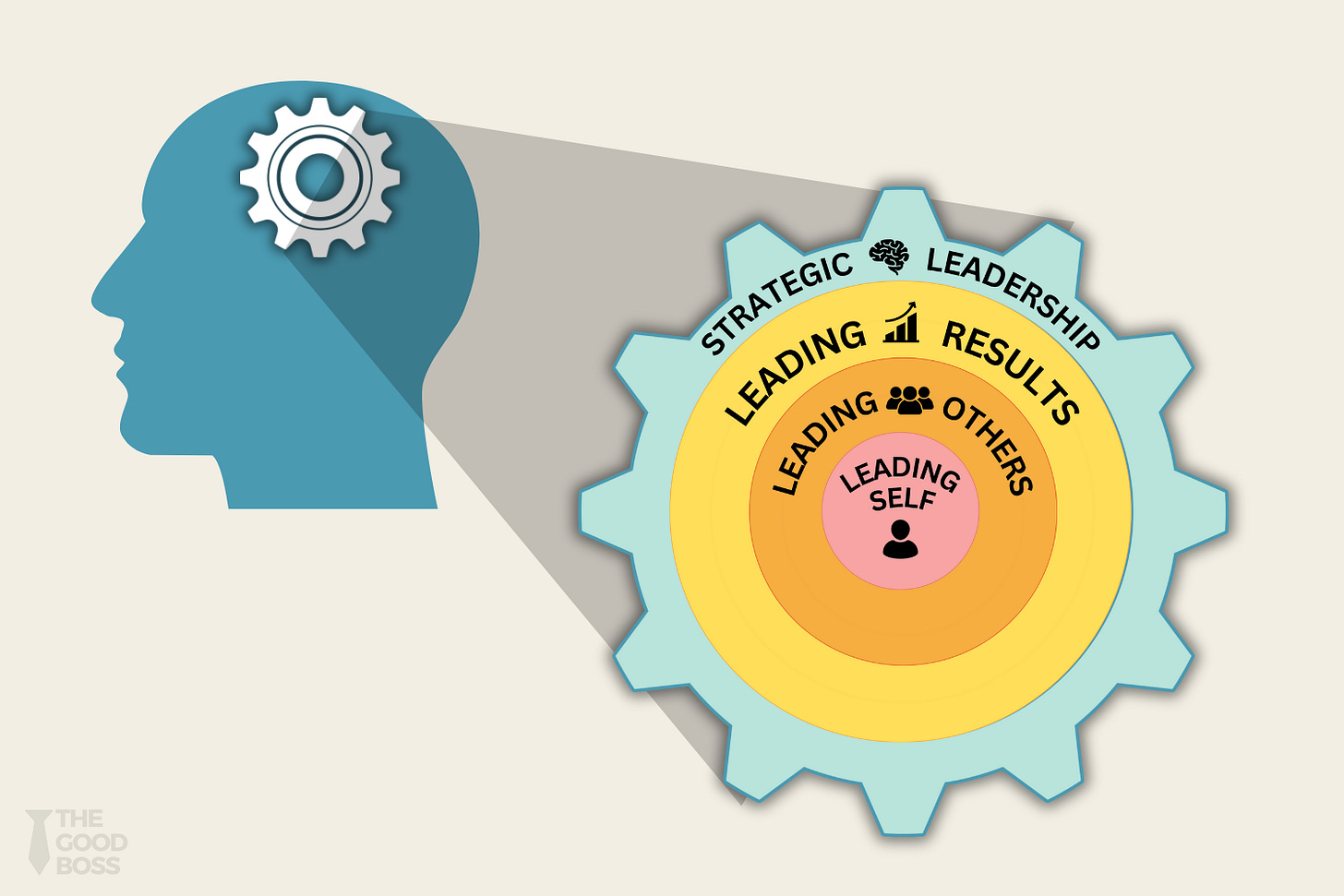

Fantastic article on how biases and different ways of thinking can get in our way as leaders.
This can be an issue at performance reviews or when interviewing people for a promotion, as biases mean we ignore facts and go with what we think is true.
The first step is an awareness of what biases exist and thinking about how to minimize them.
This article is pure gold, with plenty of insightful illustrations. Thank you Gaurav!
As leaders, we cannot pretend to know everything and be perfect, but we should be aware of those cognitive biases and the traps they create.